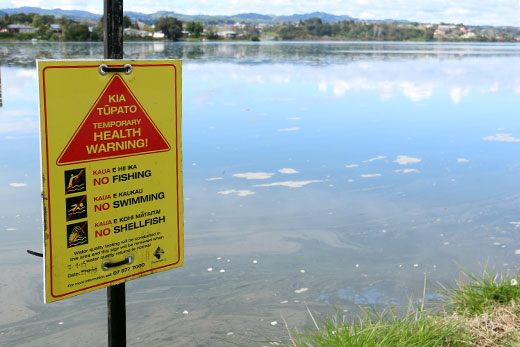Tauranga harbour's health is 'stable and showing signs of improvement” according to a report presented to the Bay of Plenty Regional Council – but remains vulnerable to the effects of land use and run-off.
And it's those vulnerabilities, insists the Regional Direction and Delivery Committee, that require ongoing efforts by locals, landowners and council staff if long-term harbour health is to be maintained and improved.
Harbour health is being described as "stable", but some hot spots still remain. Photo: SunLive.
Regional Direction and Delivery Committee Chair, Councillor Paula Thompson, says some interesting trends are starting to emerge from 10 years of water and other environmental monitoring.
'Council staff have been working hard over the last decade to support landowners and businesses in reducing erosion, sedimentation, nutrient and pollution run-off into the harbour,” says Paula.
'Our efforts seem to be turning the tide on harbour and stream health, but there's more work to do.”
The report also outlines work completed by regional council staff over the last 12 months to care for land, water and wildlife in the Tauranga Harbour catchment.
It highlights catchment-wide improvements in phosphorous levels, the general good health of aquatic wildlife populations and notes that sediment contamination levels are within safe limits.
Sea grass beds in the southern harbour are showing signs of recovery, but land run-off has caused some shellfish and sea grass decline – especially in upper estuaries of the northern harbour.
On average, all monitored swimming areas met bathing suitability standards over the 2014/15 summer season.
'There are some hotspots such as at the Kaiate Stream and McLaren Falls, where we've seen regular spikes in bacteria readings, and the Omanawa River, which has suffered increased nitrogen and phosphorous inputs since 2004,” says Paula.
'Those problems are usually caused by land-use change, weather conditions, waterfowl populations or accidental sewage overflows.
'Staff will be taking an even closer look at hotspots this year to identify further options for improvement.”
The report highlights that from July 2014 to June 2015, regional council staff worked with Tauranga City Council to audit 180 business and industrial sites to prevent storm water pollution, and collect 3,870kg of rubbish from foreshore areas with the help of more than 1500 local school children.
Throughout the year, landowners have been supported to fence and plant 62 kilometres of stream margins and to manage 900 hectares of erosion-prone land more sustainably.
The report also notes that marine pest surveillance has been completed throughout the 2014/15 year.
This involves bi-annual underwater checks on 450 moorings, 800 boat hulls, 10 kilometres of marina pontoons and 1.5 kilometres of rock walls in the Tauranga Harbour.



1 comment
improvement
Posted on 02-10-2015 06:46 | By Capt_Kaveman
lol BOPRC will post what they want, what about the pollution from the port? this harbour is filthy and i will not swim in it
Leave a Comment
You must be logged in to make a comment.